Almost all file managers for Linux like Nemo and Thunar by default provide an option to search for files. But if you want to search for a string inside a file’s content using file manager, the majority of them do not let you do so.
In this article, I’ll discuss different ways that you can use on any Linux distribution to find all files containing specific text strings or words by recursively digging through all sub-directories.
On this page
Search Specific Text in Linux Using Catfish GUI Tool
I’ll start with the easiest way that can work for all including beginners to advance Linux users. Catfish is a simple and lightweight GUI-based file search tool for Linux desktops. Along with searching for files on your system, you can also use it to find all files that contain a particular word.
[ You might also like: How to Find Files Based on Timestamp in Linux ]
Install Catfish Search Tool on Linux
The Catfish package is already available on the primary Debian and Ubuntu repositories. Hence, If you’re using Debian or Ubuntu-based distributions, you can simply install it by running the command:
$ sudo apt install catfish [On Debian/Ubuntu & Mint]
On other Linux distributions, you can install it from the default repositories using your package manager.
$ sudo yum install catfish [On CentOS/RHEL 7] $ sudo dnf install catfish [On CentOS/RHEL 8 & Fedora] $ sudo pacman -S catfish [On Arch Linux] $ sudo pkg_add -v catfish [On FreeBSD]
If the package is not available, you can download the latest release file, extract the downloaded tar.bz2 file, and run the following command:
$ sudo python3 setup.py install
Search File Contents Using Catfish
Once installed, you only need to do is enable “Search file contents”, select directories from the top-left dropdown option, and type the text you want to search for. It will list down all files containing text along with file size and location.
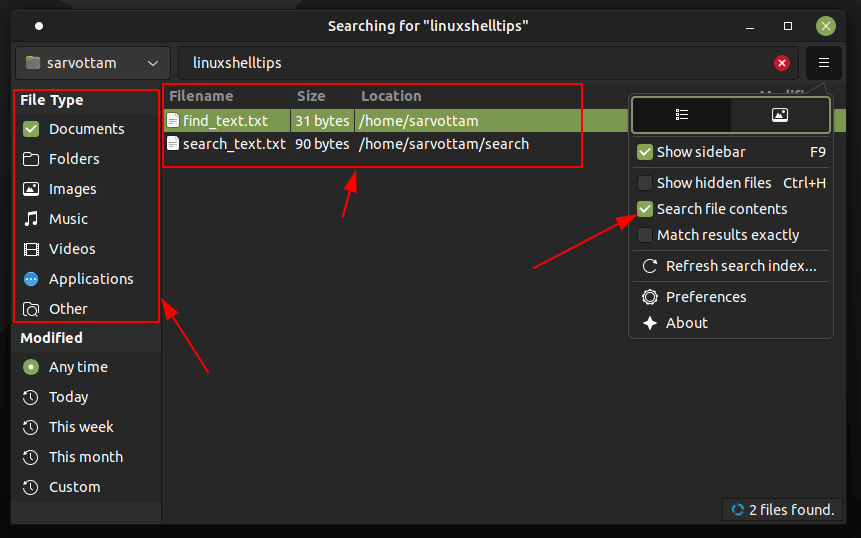
You can also use file type and modified date filter from the left panel to reduce the search scope. You can even add a directory path where you don’t want to search.
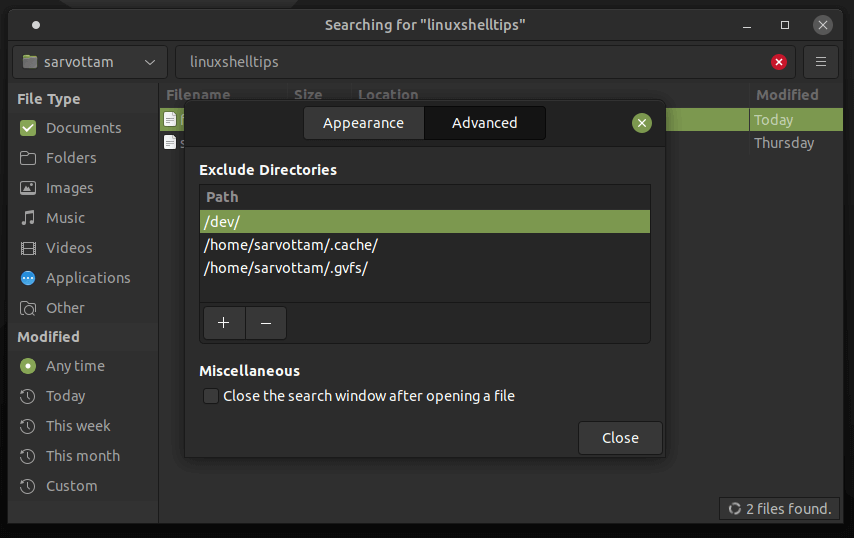
Search Specific Text in Linux Using Grep Command
Beside the GUI way, grep is one of the popular command line tools that can be used to search inside file content. Since almost all unix-like operating systems ship grep utility by default, you don’t need to install it.
Search for Particular Text in Files
Now to search and find all files for a given text string in a Linux terminal, you can run the following command. Here, the '-r' or '-R' flag recursively searches through the all subdirectories inside the specified directory.
$ grep -r “linuxshelltips” /home/sarvottam/

Find File Names That Contains a Given String
If you want to print only file names and hide the text from the output, you can use the '-l' flag.
$ grep -rl “linuxshelltips” /home/sarvottam/

Print File Names and Line Numbers That Contains a Given String
Furthermore, you can also tweak the output using the following options available for grep:
'i'for case-insensitive.'n'to print line number.'w'to match the whole word.
$ sudo grep -rnwi “linuxshelltips” /home/sarvottam/

It is also worth mentioning that if you search through directories that require root permissions, you need to use the sudo command.
Search for Specific Text in Specific File Types
To further reduce the search scope, you can also specifically mention the type of file and directories to only look for while searching. “--include”, “--exclude”, and “--exclude-dir” are the options available to add file type and directory filter.
$ grep --include=\*.txt --exclude=\*.{java,js} --exclude-dir=\bin -rnwi "linuxshelltips" /home/sarvottam/

Search Specific Text In Linux Using MC (Midnight Commander)
If you live in a terminal and still want to search text using GUI way, you can also try Terminal User Interface (TUI) based file manager tool, mc (midnight commander) – is a visual file manager that is used to search for files.
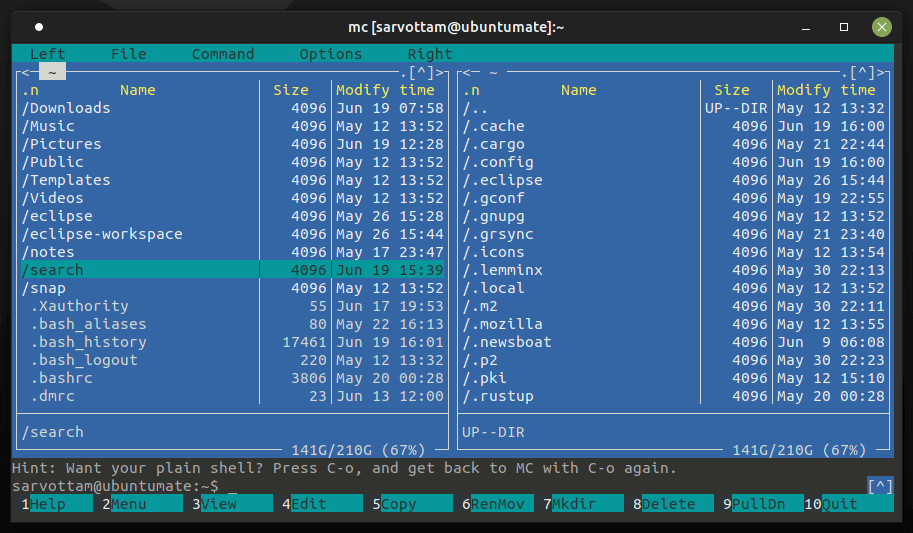
Install Midnight Commander on Linux
The Midnight Commander is available to install from the default repositories in the most of the Linux distributions.
$ sudo apt install mc [On Debian/Ubuntu & Mint] $ sudo yum install mc [On CentOS/RHEL 7] $ sudo dnf install mc [On CentOS/RHEL 8 & Fedora] $ sudo pacman -S mc [On Arch Linux] $ sudo pkg_add -v mc [On FreeBSD]
Search File Contents Using Midnigh Commander
Inside the terminal, mc provides a visual representation of the filesystem in which you can navigate either through keyboard or mouse. To search file content, you can open a search dialog using ALT+SHIFT+? and enter the text in the “Content:” section.
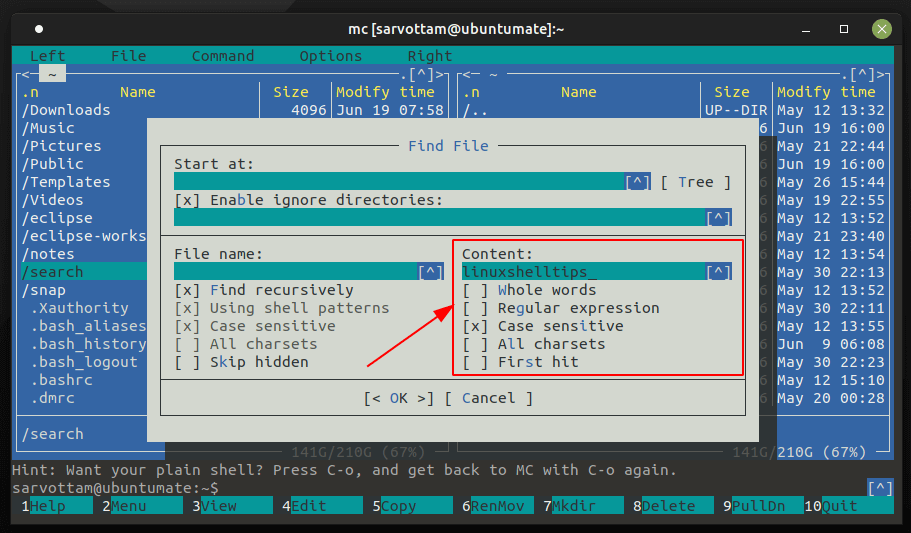
As you can see in the above picture, you can also use filters like ignore case, whole words, and regular expression by just checking and unchecking it.
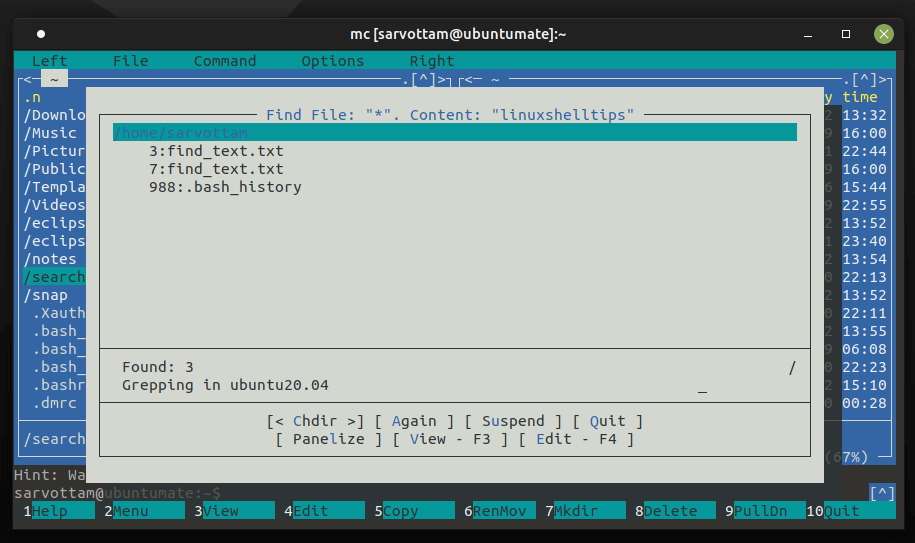
Conclusion
All the above-mentioned applications are beginner’s friendly, free-to-use and open source to add your own enhancements. Alternatively, you can also try other free tools like Ack, The Silver Searcher, Ripgrep, and find command.
